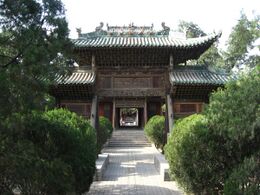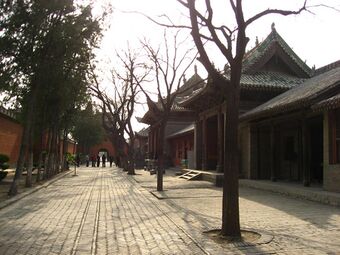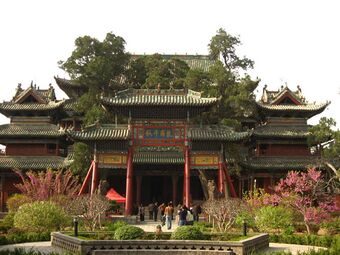Religion:Haizhou Emperor Guan Temple
| Haizhou Guandi Temple | |
|---|---|
 | |
| Religion | |
| Affiliation | Taoism |
| Location | |
| Location | Haizhou, Yuncheng, Shanxi[1] |
| Country | China |
| Architecture | |
| Date established | 589[2] |
| Expression error: Unexpected < operator. | |
Haizhou Emperor Guan Temple[3] (simplified Chinese: 解州关帝庙; traditional Chinese: 解州關帝廟), or Haizhou Guandi Temple,[4] is a temple located in Haizhou Town, Yanhu District, Yuncheng City, Shanxi Province.[5] It is hailed as "the grand ancestor of temples dedicated to Guan Yu" (关庙之祖).[6] The Temple is the largest extant palace-style Taoist complex and martial temple in China.[7]
Haizhou Emperor Guan Temple is the largest Emperor Guan Temple (关帝庙) in China .[8] It has a total area of 220,000 square meters, with more than 200 rooms.[9]
History
Haizhou Emperor Guan Temple was established in the ninth year of Kaihuang (开皇) in the Sui Dynasty (589), expanded and rebuilt in the Song Dynasty and Ming Dynasty.[10]
Haizhou Emperor Guan Temple was destroyed by fire in the forty-first year of Kangxi (1702) in the Qing Dynasty and was restored after more than ten years.[11]
Conservations
In 1957, Haizhou Emperor Guan Temple was designated by the Shanxi Provincial People's Government as the first batch of provincial-level key cultural relics protection units in Shanxi Province.[12]
In 1988,[13] Haizhou Emperor Guan Temple was listed as a Major Historical and Cultural Site Protected at the National Level in China.[14]
References
- ↑ "Eight boutique lines leisure tour of Shanxi". 2015-07-24. http://www.xinhuanet.com/travel/2015-07/24/c_128051966.htm.
- ↑ Hu Miaosen; Jiang Zhuping (2005). China Building Map. Bright Daily Press. pp. 98–. ISBN 978-7-80145-913-8. https://books.google.com/books?id=z2ZEAAAAMAAJ.
- ↑ Stanley Henning (9 March 2018). Henning’s Scholarly Works on Chinese Combative Traditions. Via Media Publishing. pp. 73–. ISBN 978-1-986369-24-4. https://books.google.com/books?id=JNwPEAAAQBAJ&pg=PT73.
- ↑ "Haizhou Guandi Temple Cultural Resource Development of Cultural Industry Perspective". China National Knowledge Infrastructure. 2017-10-16. https://gb.oversea.cnki.net/KCMS/detail/detail.aspx?filename=1016166112.nh&dbcode=CMFD&dbname=CMFD2017.
- ↑ "Haizhou Emperor Guan Temple (photoes)". Sohu News. 2007-05-13. http://news.sohu.com/20070513/n249989097.shtml.
- ↑ Michael DeMarco (17 August 2016). Bagua and Xingyi: An Intersection of the Straight and Curved. Via Media Publishing. pp. 128–. ISBN 978-1-893765-33-7. https://books.google.com/books?id=sDUPEAAAQBAJ&pg=PT128.
- ↑ "National Day Long Vacation Shanxi waiting for you to come". Science Guide. 2019-09-24. http://www.kxdb.com/index.php/News/news/articleId/19890.
- ↑ "More than 40 stone monkeys "hide" in China's largest Emperor Guan Temple". Feb 25, 2016. http://www.xinhuanet.com/politics/2016-02/25/c_1118154595.htm.
- ↑ "Aerial photography of Haizhou Guandi Temple in Shanxi". China News Service. 2016-09-26. http://www.chinanews.com/m/tp/hd/2016/0926/91201.shtml.
- ↑ "Shanxi promotes tourism in Northeast China". China Daily. 2015-06-25. https://www.chinadaily.com.cn/m/shanxi/pingyao/2015-06/25/content_21113454_6.htm.
- ↑ "Haizhou Guandi Temple in Yuncheng". China News Service. 2007-05-26. http://www.chinanews.com/gj/kong/news/2007/05-26/944055.shtml.
- ↑ "Haizhou Emperor Guan Temple". China National Knowledge Infrastructure. 2016-10-14. http://www.cnki.com.cn/Article/CJFDTotal-WSYK201610014.htm.
- ↑ ""Guan Sheng Cultural Complex" heritage application materials will be submitted to the State Administration of Cultural Heritage". China News Service. 2014-03-27. http://www.chinanews.com/cul/2014/03-27/6000195.shtml.
- ↑ "Shanxi Haizhou Emperor Guan Temple Scenic Area". 2018-05-11. http://www.xinhuanet.com/travel/2018-05/11/c_1122817360.htm.



